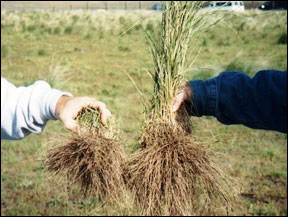
We can only see what?s above ground. The plant on the left has recently been grazed, notice the roots that have died back. How long until the roots have completely recovered?
Based on our grazing work in North America, we’ve concluded there is probably no more important – yet less validated – grazing attribute than proper recovery period. Plants that are grazed simply need adequate time to recover from defoliation.
Just because it grows back, doesn’t mean it’s recovered.
If the recovery period is insufficient, for too long, the desired plants will be ultimately subdued and/or replaced by other, better adapted species. Unfortunately “subdued plants” are tired plants, they can perform very poorly, are more drought sensitive, have lower quality, and may not reproduce. While “replacement species” are usually vigorous, they are almost always less desirable, less productive, and can easily overtake a weakened pasture.
Then we spend our time unknowingly treating the symptoms by spraying, burning, applying animal impact, reseeding, or otherwise fighting back while our desired plant community may be just simply, tired and needing a rest. Does this sound familiar?
Think about RECOVERY.
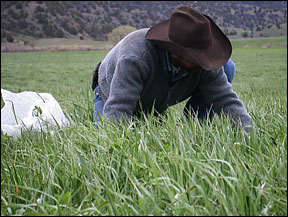
Irrigated meadow of introduced grasses. The recovery period required for this pasture is much shorter than that of a native pasture.
When contemplating recovery periods, three things should be considered; 1) moisture conditions, 2) plant type and then 3) grazing intensity. Let’s use a simple “controlled” example: Irrigated pasture. Under these conditions there is a lot of grace (consistent moisture and hardy plants), and recovery periods can be relatively short and become primarily a function of grazing intensity.
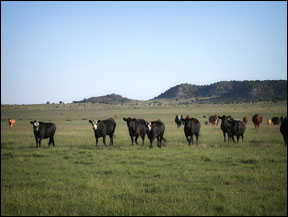
Native pasture in New Mexico. The managers will be resting this pasture for 1-1/2 growing seasons before grazing it again.
Now let’s consider less “controlled” situations: rangelands-natural rainfall (<20″), native plants, and moderate grazing use. Typical locations might be: Big Timber MT, Bison SD, Ten Sleep WY, Salida CO, Ellensburg WA, O’Neal NE, Raton NM, or Buffalo OK.
Based on these intermountain and western plains areas, we have begun to see the impressive results using extended recovery periods ranging from 13- 30 months in duration.
And guess how we’ve come to these conclusions?
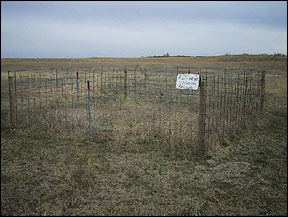
A permanent exclosure (recovery pen) in Nebraska. Deep rooted, native plants appearing in the middle of a cheatgrass dominated area!
So what IS the proper rest period for your country? Why don?t you ask it? One of several simple monitoring devices we encourage is to construct a permanent grazing exclosure – call it a recovery pen if you?d like. Picture at least a 16’x16′ area (or larger) permanently fenced, pen sized area, located at a few places on the ranch. Once completed, just be patient, and watch.
What we have observed thus far, in all cases, is improvement. It may start slowly at first (1 or maybe 2 growing seasons), but then ecological aspects will begin to move ahead positively (improved infiltration, new species, higher production to name a few) for the next 1-2 years. Following this, with no grazing a permanent period of decline will at some point begin to occur.
There are managers who are moving to these “extended recovery periods” with success, and in one case a Montana rancher now essentially carries his whole herd on 1/3rd of his ranch (using multiple pastures) each year, resting the other 2/3rds. Each year the herd moves onto the “1/3” which has been rested for 2 years. Though utilization is high, and animal performance just adequate, his pastures look exceptional. I believe he has keyed in on the idea of recovery. Is his approach sustainable? – time will tell.
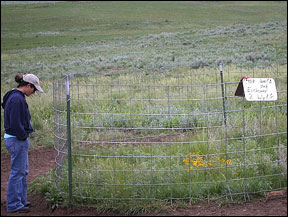
Recovery pen in Montana – three years of rest. Vigorous and diverse native grasses and forbs, twice the production of the surrounding area (composed of low successional plants).
There a lot of ranchers who are likely aware of old permanent exclosures in their area. For years these “examples” have been used to show the negative long term effects of NOT GRAZING (kind of old news actually). And most of the time this is true. However, what we are saying is to really observe the short term (2-4 year) effects of rest and what it may produce.
We have now seen in all cases so far, that 2-4 years of rest have dramatically changed and improved water infiltration, organic matter, desirable plants, species diversity, plant vigor, and production. In some cases, native species we didn?t know could be present have begun to show up and thrive.
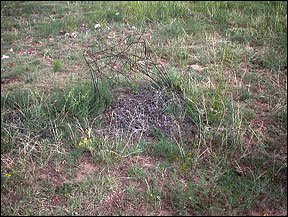
Folks, this is NOT a permanent exclosure! – although the rancher we were visiting called it one (just teasing, Tim)
The first step: Don?t take our word for it.
We encourage you to really think about your recovery periods and ask yourself how they were determined. Then you might want to ask your land instead of a book or your neighbor. Unfortunately, there are a number of land managers who are failing in their mission because they are so focused on ?doing things right? (and by the book) that they miss answering the most important question: Are they “doing the right things”? (looking at the land).
So, here is a “right thing” suggestion – try building a few of these “recovery pens” on some of your different land types (or concern areas) and watch them over the next few years – and pay attention. If nothing changes then it is good confirmation of your management. But if change does occur, the land may be trying to tell you something.
And if you want to have better skills to quickly track and validate management practices, small lessons like this, taught at Land EKG schools, can certainly help.
If you have interest or questions regarding a school for your area, please give us a call at (307) 366-2445 or go to our contact page.
IN OUR NEXT LAND EKG E-NEWSLETTER ISSUE:
New Concepts for the Grazing Index
If you have any suggestions for future issues, have feedback, or want more information please contact us at:
(307) 366-2445 or contact us by email.
